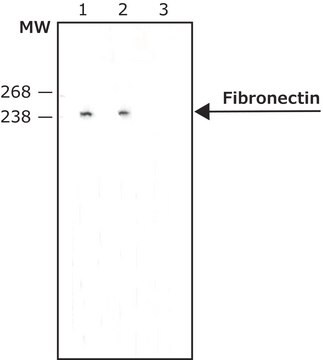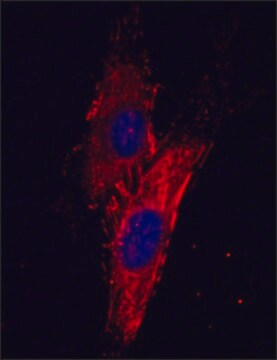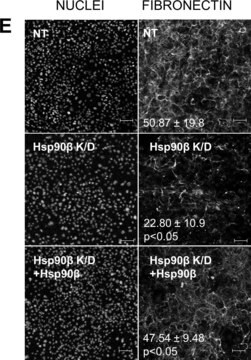MAB1934
Anti-Fibronectin Antibody, cell binding peptide, clone 784A2A6
purified antibody, clone 784A2A6, Chemicon®
About This Item
WB
western blot: suitable
Recommended Products
biological source
mouse
Quality Level
antibody form
purified antibody
antibody product type
primary antibodies
clone
784A2A6, monoclonal
species reactivity
human, chicken
manufacturer/tradename
Chemicon®
technique(s)
ELISA: suitable
western blot: suitable
isotype
IgG1
UniProt accession no.
shipped in
wet ice
target post-translational modification
unmodified
Gene Information
chicken ... Fn1(396133)
human ... FN1(2335)
Specificity
Immunogen
Application
Microscopy
Western blotting at 1-5 μg/mL
Cellular Adhesion Studies
Note: Dilution without addition of carrier protein may cause denautration or adherence of the antibody to the vial. Dilution into a 1% bovine serum albumin containing buffer is recommended.
Optimal working dilutions must be determined by end user.
Cell Structure
ECM Proteins
Physical form
Storage and Stability
Other Notes
Legal Information
Disclaimer
Not finding the right product?
Try our Product Selector Tool.
Storage Class
10 - Combustible liquids
wgk_germany
WGK 2
flash_point_f
Not applicable
flash_point_c
Not applicable
Certificates of Analysis (COA)
Search for Certificates of Analysis (COA) by entering the products Lot/Batch Number. Lot and Batch Numbers can be found on a product’s label following the words ‘Lot’ or ‘Batch’.
Already Own This Product?
Find documentation for the products that you have recently purchased in the Document Library.
Our team of scientists has experience in all areas of research including Life Science, Material Science, Chemical Synthesis, Chromatography, Analytical and many others.
Contact Technical Service




